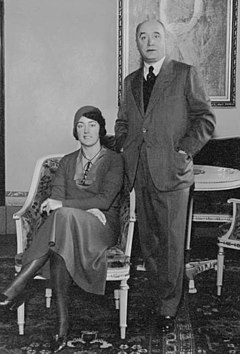Friedrich Bergius
Friedrich Karl Rudolf Bergius | |
|---|---|
| Scientific career | |
| Fields | Chemistry |
| Institutions | Leibniz University Hannover |
| Doctoral advisor | Arthur Rudolf Hantzsch[citation needed] |
| Other academic advisors | Richard Abegg |
Friedrich Karl Rudolf Bergius (German pronunciation:
Bergius was born near Breslau (Wrocław), within the German Empire's Prussian Province of Silesia.
Academic career
Before studying chemistry, Bergius was sent to work for 6 months at the Friedrich Wilhelms
Work
Synthetic fuel from coal
During his habilitation, techniques for the high-pressure and high-temperature chemistry of carbon-containing substrates were developed, yielding a patent on the
Sugar from wood
The hydrolysis of wood to produce sugar for industrial use became a hard task for Bergius. After he moved to Heidelberg he started to improve the process and planned an industrial scale production. The high costs and technical problems nearly led him to bankruptcy. A bailiff followed Bergius to Stockholm to get the money from his Nobel Prize in Chemistry in 1931.
The autarky movement before the World War II boosted the process and several plants were built. Bergius moved to Berlin where he was only marginally involved in the development. While he was in Bad Gastein Austria, his laboratory and his house were destroyed by an air raid. The rest of the war he stayed in Austria.
International engagement
After the war his citizenship was called into question because of his collaboration with IG Farben, resulting in his departure from Germany to work as an adviser in Italy, Turkey, Switzerland and Spain. He emigrated to Argentina, where he worked as an adviser to the Ministry of Industry. He died in Buenos Aires on 30 March 1949, and is buried in the Cementerio Alemán next to La Chacarita Cemetery.
Awards

He and Carl Bosch won the Nobel Prize in Chemistry in 1931 in recognition of their contributions to the invention and development of chemical high-pressure methods. In 1937, he was awarded the Wilhelm Exner Medal.
Personal life
Bergius was the father of Renate Burgess.[3]
References
- ^ "New Scientist", Vol. 104, No. 1426. 18 October 1984. ISSN 0262-4079. Archived 2014-07-07 at the Wayback Machine
- ISBN 978-0-465-00338-9.
- ISBN 978-0-7876-7676-6.
Further reading
- Kerstein, Gunther (1970). "Bergius, Friedrich". ISBN 0-684-10114-9.
- Anthony N. Stranges (1984). "Friedrich Bergius and the Rise of the German Synthetic Fuel Industry". Isis. 75 (4): 642–667. S2CID 143962648.
- Dietrich Stoltzenberg (1999). "Fritz Haber, Carl Bosch und Friedrich Bergius – Protagonisten der Hochdrucksynthese". Chemie in unserer Zeit. 33 (6): 359–364. .
- Robert Haul (1985). "Das Portrait: Freidrich Berguis (1884–1949)". Chemie in unserer Zeit. 19 (2): 59–67. .
External links
 Media related to Friedrich Bergius at Wikimedia Commons
Media related to Friedrich Bergius at Wikimedia Commons- Friedrich Bergius on Nobelprize.org including the Nobel Lecture, May 21, 1932 Chemical Reactions under High Pressure
- Newspaper clippings about Friedrich Bergius in the 20th Century Press Archives of the ZBW

